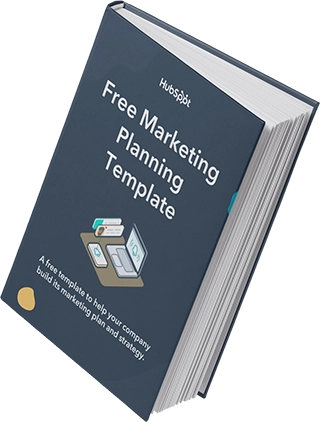If someone asks you to list a few marketing goal examples, could you?
When many think of marketing, they go to the big flashy examples – like SuperBowl commercials and Spotify’s annual "Wrapped" campaigns. But the truth is, that’s likely the result of months of strategizing.
Before you can build your strategy though, you first need a clear goal. What does your business want to accomplish? Maybe you need more traffic to your website or perhaps you want to generate more leads.
If you need help figuring out what that is, we’ve got you covered.
What are marketing goals?
A marketing goal is a specific and measurable objective that helps you meet your broader business goals. It can be anything from generating high-quality leads and raising brand awareness to increasing customer value and improving your referral rate.
A campaign without a clear goal is essentially a waste of money. Because you won’t know how to measure the impact or value of the work you’ve put in.
Goals are there to provide clarity, purpose, direction and vision. Whether personal or commercial, they are what lead to success for you, your department, and the business as a whole. Hitting your goal proves you're making an impact. We all want to feel like we're contributing, right?
Here, we're going to explore the major goals you should consider when creating and implementing a marketing strategy. These goals should help you achieve maximum results in 2022 and beyond.
Marketing Goal Examples
- Increase brand awareness.
- Generate high-quality leads.
- Acquire new customers.
- Increase website traffic.
- Establish industry authority.
- Increase customer value.
- Boost brand engagement.
- Increase revenue.
- Improve internal brand.

Free Marketing Plan Template
Outline your company's marketing strategy in one simple, coherent plan.
- Pre-Sectioned Template
- Completely Customizable
- Example Prompts
- Professionally Designed
Download Free
All fields are required.

1. Increase brand awareness.
In 2021, we surveyed over 1,000 global marketers – 48% of marketers surveyed said their primary goal when running marketing campaigns was increasing brand awareness.
Brand awareness is key to gaining customers because after all, if consumers don’t know you exist, how will they know what you have to offer?
Every brand has a personality — a human voice shaped by the tone you strike and the platforms you're using and the subjects or topics you're talking about. If your goal is to raise brand awareness, figuring out what that personality is and how that voice sounds is the place to start.
From there, here are some tactical steps:
- Tell a story – Consumers engage with brands they feel connected to and storytelling is an incredibly powerful tool to do it. To craft your narrative, think about your origin story and what adds humanity to your brand.
- Consider where your target buyers spend the most time – Online, this might look like a particular social network like Instagram or TikTok. It could also be a specific channel like email and podcasts. You want to meet your audience where they are
- Share and engage constantly – Once you know what story you want to tell and where your audience is, all that’s left is to engage with them. This can look like posting interesting content on social media, having a blog or guest blogging to share industry insights, and conducting polls.
You're more than a business that sells a product or service. As you have a positive impact on your audience, they'll likely turn into advocates of your brand, sharing your content and passing along their positive experiences to friends, family, and colleagues.
Top brand awareness tip: It's not all ‘me me me'. A conversation goes two ways, so don't forget to stop and listen to what the people you're trying so hard to reach are saying back to you. You never know — they might just have some valuable insights or great ideas.
How do you measure brand awareness?
Although brand awareness can be a hard metric to track and measure, you can review the effectiveness of your activities by looking at your quantitative metrics such as:
- Brand mentions, reach, follower count for social media
- Branded search volume, website traffic, backlinks for SEO
To learn more about increasing brand awareness, read this Ultimate Guide to Brand Awareness.
2. Generate high-quality leads.
Your sales department depends on a consistent stream of leads to nurture and turn into new customers.
You're not their only source of leads, but it's safe to say your colleagues over in sales are depending on you to convert leads into new contacts to which they can reach out.
27% of marketers surveyed in 2021 by HubSpot Blog Research said generating leads and traffic was the biggest challenge they faced in 2021. What’s more, 21% say they expect to meet that same challenge in 2022.
From tried-and-tested methods like on-page forms to innovative features like chatbots, there are many ways to drive marketing-qualified leads.
Here’s an example of a lead-gen strategy:
- A website visitor discovers your site through an ad and arrives at a landing page.
- They click on the call-to-action to receive a content offer, otherwise known as a lead magnet.
- To download the form, they must first fill out a form (known as a lead capture form).
- After filling out their name and email, they access the content offer download page.
This is followed by a nurturing strategy to guide the user down the sales funnel.
There are many ways to generate leads, including:
- Email newsletters
- Retargeting ads
- Content marketing
- Social media
If you’re having trouble driving leads, create a report of all the leads coming in and section out those who've been disqualified, and why. This can help refine your marketing processes and continuously improve the quality of leads coming in.
How do you measure high-quality leads?
Analyze trends across the leads who eventually turn into customers. Create goals and custom reports such as multi-touch revenue attribution reports, customize your dashboards, report on revenue, and more.
If you're looking for tools to create and track effective marketing goals for an entire marketing team, check out HubSpot's Marketing Hub.
3. Acquire new customers.
Gaining customers is key to expanding your reach and growing your business. Many companies struggle to build a sustainable strategy that will scale.
For instance, say your main customer acquisition play is by leveraging content marketing. Do you have a strong team to build out a style guide and content strategy then execute on it for your chosen channels?
Or say you use a freemium model, by giving consumers a taste of your product to attract and hopefully convert them to the paid version. Do you have a strong conversion strategy and a team that can focus on optimizations?
To build a strong marketing strategy with the goal of acquiring new customers, focus on leveraging sustainable and flexible tactics that will scale with your business.
How do you measure customer acquisition?
- Customer acquisition cost (CAC)
- Total new customers
- Churn rate
- Product sign-ups

Free Marketing Plan Template
Outline your company's marketing strategy in one simple, coherent plan.
- Pre-Sectioned Template
- Completely Customizable
- Example Prompts
- Professionally Designed
Download Free
All fields are required.

4. Increase website traffic.
In this digital age, getting strong traffic to your website is one of the major signs of a successful marketing strategy.
In fact, 54% of marketers surveyed in 2021 say web traffic is the most important metric when measuring the effectiveness of their content marketing efforts.
So, how do you accomplish this? Here are a few strategies:
- Increase your paid ad campaigns.
- Double down on your SEO efforts to increase your search engine ranking.
- Start a blog.
- Ensure all marketing channels circle back to your website.
How do you measure website traffic?
- Total sessions
- Total unique pageviews
- Average time spent on page
- Bounce rate
- Conversion by traffic source
5. Establish industry authority.
It doesn't matter what industry you find yourself in — being recognized as an expert in your field is fundamental for proving a high level of knowledge and credibility.
Not to be confused with brand awareness, thought leadership is about consumers recognizing your brand — and the people within your business — as among the best and most trustworthy in the industry.
On the other hand, brand awareness is more about making sure your brand is heard, seen, and recognized at all.
There are different ways to develop and maintain thought leadership. One of those methods is by publishing and sharing content that inspires your audience and speaks to their pain points.
Leveraging partner networks to ensure you're able to reach a larger audience and appear up-to-par with other industry leaders is another approach to thought leadership.
For instance, building an external community through outreach and guest blogging is great for working with other trusted and reputable brands in the industry to create valuable content.
As you build your thought leadership strategy, consistency becomes essential to maintaining it. Publishing and sharing your content consistently is important to continue to appear relevant and forward-thinking in your industry.
Alternatively, you might consider hosting a webinar or panel discussion with other major industry leaders.
How do you measure thought leadership?
Similar to brand awareness, thought leadership can be tricky to measure.
One way to do it is through media mentions. If your brand is mentioned often in relation to your industry, that’s a good indicator that you have a strong thought leadership program. A high branded search volume and a high number of backlinks can also be indicators of success.
To learn more about thought leadership, take a look at The Content Marketer's Guide to Thought Leadership.
6. Increase customer value.
The marketing conversation has moved well beyond simply generating new business. Today, it's more important than ever that you're delighting your existing customer base, keeping the people your business depends on happy and, whenever possible, helping them to promote you.
Delighted people won't just buy from you again — they'll also refer you to their friends and colleagues, too.
If your goal is to help retain and grow your existing customers, there's plenty you can be doing to achieve it:
- Get your customer data in order, from purchases to net promoter score.
- Build a loyalty program where customers can get early access to products and discounts.
- Launch a referral program.
- Share customer success stories.
How can you tell if you're increasing customer value?
You'll want to measure your upsell targets or retention targets to evaluate whether you're increasing customer value and loyalty over time.
Additionally, closely monitor what content you share with customers that influenced the most deals, or the last piece of content they interacted with before a deal closed. This will help you visualize which content is most valuable to your existing and new customers.
7. Boost brand engagement.
Brand engagement tells you that your audience is listening to you and enjoys your content. What’s better than that?
Boosting brand engagement won’t happen overnight. In fact, it can take months to see the impact of your efforts. However, when it does happen, you can see strong results on your reach and more importantly, your revenue.
Here are the steps you can take to do so:
- Identify what your audience cares about.
- Be consistent about sharing valuable content.
- Encourage action by initiating conversation and inviting your audience to join.
- Host giveaways and contests.
- Personalize communications when possible.
What you’re doing through these steps is building a community. A loyal community will engage with your audience and better yet, they’ll spread the word to others.
How can you tell if you’re boosting brand engagement?
This will depend on the channel you’re checking and where on the funnel you’re focusing on. For instance, on social media, likes, shares, comments, and retweets are considered engagement.
With email, engagement will look like opens and clicks.
These are channels mostly used for top- to mid-funnel engagement. For customers, engagement metrics can be:
- Net promoter scores (NPS)
- Customer satisfaction score
- Referrals
- Average website session duration
8. Increase revenue.
According to 2021 HubSpot Blog Research data 43% of marketers surveyed say their primary goal when running marketing campaigns in 2021 was increasing revenue – making it the second highest goal behind brand awareness.
Marketing can play a huge role in increasing revenue as they can target consumers at every stage of the funnel.
Here are some marketing strategies you can use at every stage:
- Top of the funnel – Build a strong digital presence on social media and web, create content your audience cares about on the channels they consume, develop content offers to turn visitors into leads.
- Middle of the funnel – Identify signals that turn prospects into MQLs, automating lead nurturing emails, retargeting campaigns.
- Bottom of the funnel – Create tutorials, share product demos and customer success stories.
- After-purchase – Build a customer loyalty program.
Keep in mind that this list isn’t exhaustive but it can help you get started.

Free Marketing Plan Template
Outline your company's marketing strategy in one simple, coherent plan.
- Pre-Sectioned Template
- Completely Customizable
- Example Prompts
- Professionally Designed
Download Free
All fields are required.

What are some metrics to track increasing revenue?
- Annual Recurring Revenue
- Average Revenue Per User
- Quota Attainment
- Win Rate
10. Improve internal brand.
Increasingly, marketing teams are also taking on responsibilities around internal communications and educating employees across the business on the tools and resources they need to succeed when selling or providing service to customers.
Do your colleagues understand your brand's target personas and what they need at their respective stage in the buyer's journey?
It's important to ensure all employees are given what they need in order to talk about the business with confidence to prospects and customers and become ambassadors for your brand.
How can you tell if you're empowering colleagues?
If you've delivered an internal newsletter, review its performance data to determine whether or not your colleagues across the company are actually opening it and clicking through the relevant resources contained within.
Alternatively, was your goal to educate the team about a new product or updated messaging?
A company-wide survey can take very little time to create and can provide you — and the rest of your team — with valuable feedback on your efforts.
By now, you should be well on your way to setting and achieving your own SMART marketing goals.
Remember, whichever goals you set for yourself and your team, they have to serve a purpose and benefit the business as a whole.
Whether that means generating high-quality leads for sales or stepping up your brand awareness game, you'll be ready to increase revenue and enable your business to grow better in no time.
Editor's Note: This post was originally published in April 2020 and has been updated for comprehensiveness.
Marketing Strategy








![The state of inclusive marketing in 2025 [new data + expert insight]](https://53.fs1.hubspotusercontent-na1.net/hubfs/53/inclusive-marketing-report.webp)
![How marketers are navigating a possible recession (and advice about what you should do during it) [new data]](https://53.fs1.hubspotusercontent-na1.net/hubfs/53/image12-May-27-2025-02-18-19-8390-AM.png)



![Cultural Marketing: What It Is & How to Do It The Right Way [According to Experts]](https://53.fs1.hubspotusercontent-na1.net/hubfs/53/Untitled%20design%20-%202025-04-03T163531.949.jpg)